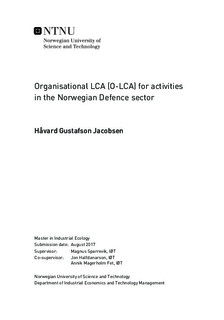Organisational LCA (O-LCA) for activities in the Norwegian Defence sector
Master thesis
Permanent lenke
http://hdl.handle.net/11250/2482479Utgivelsesdato
2017Metadata
Vis full innførselSamlinger
Sammendrag
Over the past several years, The Defence Research Institute (FFI) has prepared annual environmental reports of the activities in the Norwegian Defence sector, for tracking environmental performances. As a continuous step towards this work, the Norwegian Defence sector has expressed the need for conducting an organisational life cycle assessment (O-LCA). An O-LCA includes the indirect greenhouse gas (GHG) emissions for which the environmental report does not, yielding the total carbon footprint (CF) of the organisation.
The O-LCA was conducted for day-to-day operations, using a hybrid LCA approach, by means of both process and economic data. The process data were collected from the environmental report of 2016, while the economic data was collected from Direktoratet for Økonomistyring. The tool SimaPro were used to calculate the process emissions, whereas emissions factors produced by Asplan Viak was used to calculate the economic emissions.
The CF of the process emissions amounted to 421 000 tonnes CO2-eq, and the economic emissions deduced from the day-to-day operation procurements of 15,4 billion NOKs, accumulated to 379 000 tonnes CO2-eq. The total carbon footprint of the Norwegian Defence sector for 2016 sums up to 800 000 tonnes CO2-eq. The largest contribution (44 % of total CF) stems from transportation related activities, while building and construction is the second largest (25 % of total CF).
The total CF is broken down into scope emissions, which dictates direct and indirect categorisation of emissions. Scope 1, Scope 2 and Scope 3 contributed 30 %, 3 % and 67 %, respectably, giving direct emissions a 30 % share, while indirect a 70 % share of the total CF.
Environmental hotpots for the organisation has been identified and presented, giving a good starting point for further research. Recommendations has been given for further work on each one of the hotspots, though it should be noted that these are just suggestions, not guidance.
